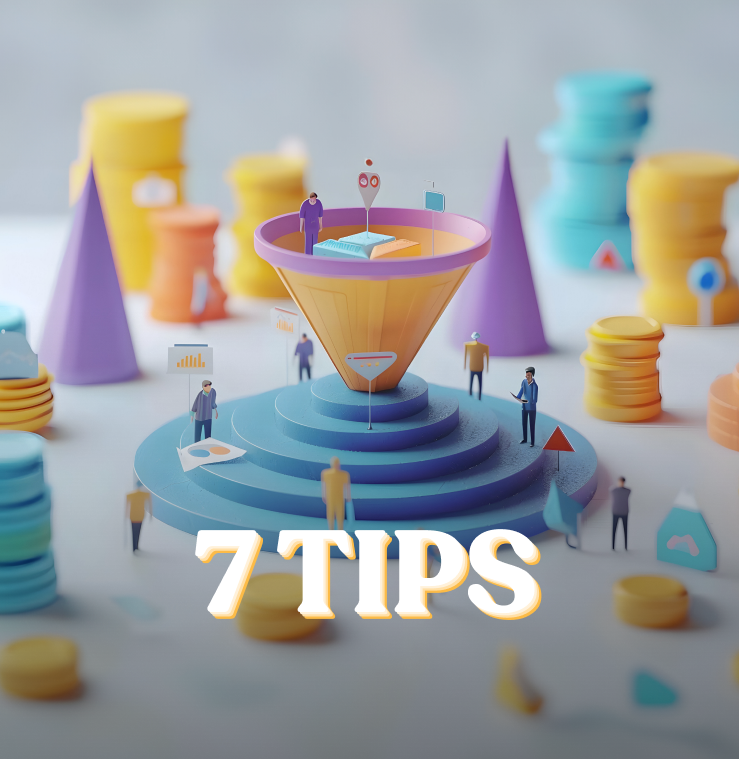Imagine having a video sales funnel that’s not just a fancy marketing tool, but a magnet for leads and a catalyst for conversions. Sounds like a dream, doesn’t it? Well, I’m here to tell you it’s entirely achievable.
In the digital age, video content is king. It’s engaging, shareable, and, most importantly, it sells. But how do you harness its power to create a sales funnel that attracts and converts? That’s what we’ll explore in this article.
We’ll break down the process into seven manageable steps, from understanding your audience to tracking your results. By the end, you’ll have a roadmap to creating a video sales funnel that truly works for your business. So, let’s get started, shall we?

Understanding Video Sales Funnels
To dive deeper into the intricacies of developing a successful video sales funnel, I believe a foundational understanding of the concept is essential. I’ll focus on clarifying what a video sales funnel is and discussing the significance of video in marketing.
What Is a Video Sales Funnel?
Think of a video sales funnel as a system. It’s designed to attract, engage, and finally convert prospects into customers. It all begins with awareness. A potential customer chances upon a piece of video content, often hosted on a platform such as Facebook or YouTube. This video’s primary goal isn’t necessarily to sell. Instead, it serves as an introduction, building the brand’s image in the viewer’s mind. Videotree platform also helps create engaging video funnels to attract potential customers, sales, and more.
Next, the funnel moves into its engagement phase. Here, the prospect sees more videos. These might be in-depth tutorials, product demos, or other content that provides deeper insight into the brand. Purpose? To pique the viewer’s interest and lead them closer to a purchase decision.
Finally, the conversion phase occurs. At this point, focused video content urges the viewer to take a specific action – to buy, sign up or visit a website. This three-step process – attracting, engaging, converting – forms the core of any well-structured video sales funnel.
Importance of Video in Marketing
Video holds a significant place in the digital marketing sphere. Given our innate love for visual content, it’s no surprise. Research indicates, such as Brightcove’s 2018 report, that 76% of consumers state they’ve purchased a product after viewing a video.
Let’s also not forget that video marketing yields strong SEO benefits. Videos tend to keep site visitors longer, leading to lower bounce rates. Plus, videos encourage shares on social media, boosting exposure and potentially inbound link generation.
Step 1: Defining Your Target Audience
Integral to the development of a video sales funnel is the accurate definition of your target audience. Without this, my efforts may become inefficient and ineffective.
Researching Customer Demographics
Comprehending my customer demographics forms the bedrock of this step. I delve into specifics like age groups, gender, geographical location, and socioeconomic status. For example, if I run a high-end cosmetics business, my key demographic could be females between the ages of 25 to 44, with an average or above-average income.
Noteworthy is the segmenting of my audience based on these demographics: it enhances my understanding and allows me to reach them effectively. Multifarious tools assist me in obtaining this data, such as Google Analytics, Facebook Audience Insights, and customer feedback.
Tailoring Content to Audience Needs
Armed with the knowledge procured from researching demographics, I now suit my content to meet the needs of my target audience. Paramount is the creation of personalized content which resonates with their challenges, preferences, and desires. If my target audience is parents, I accentuate how my products ease their pain points or add value to their lives.
I use the AIDA model (Attention, Interest, Desire, Action) to ensure my content drives results. For example, I grab attention with compelling headlines, sustain interest with engaging narratives, amplify desire with vivid descriptions, and urge action with strong call-to-actions.
In essence, defining my target audience holds the reins in developing a video sales funnel that attracts and converts. With a decisive understanding of who my audience is and what they want, I’m set on the path of creating compelling video content that resonates and generates impact.
Step 2: Creating Compelling Content
Now that you’ve got your audience clearly defined, it’s time to dive into creating the kind of content that captivates, and convinces them to take a closer look at what you’re offering. Here, different stages in the sales funnel call for varied types of videos and unique engagement approaches.
Types of Videos for Each Funnel Stage
The type of video content you create can dictate its effectiveness at a given funnel stage. At the top of the funnel (TOFU), educational videos—like how-tos, webinars, or explainer videos—prove useful. These engage potential customers and provide value first, instead of pushing for a sale. An example of an educational video could be a tutorial on how to use a software product you’re selling.
In the middle of the funnel (MOFU), your content should be more product-centric. Here, testimonial videos, case studies, and product demos play a pivotal role. These present proof of your product’s worth and inspire trust. For instance, featuring a case study of a satisfied customer might be a driving factor for prospects at this stage.
At the bottom of the funnel (BOFU), personalize your video to your prospects’ specific needs. Personal videos, product walkthroughs, and even free consultations can take center stage, geared towards closing a sale. An example would be a personalized video response addressing a prospect’s particular concerns or questions about your product.
Tips for Engaging Video Content
Creating great video content is not just haphazardly throwing together some visuals and text. It’s vital to deliver value, keep viewers engaged, and have a clear call to action (CTA) amongst other things.
- Humanize Your Brand: Use video content as a bridge to connect with your audience on a personal level. Authenticity wins people over. For instance, behind-the-scenes videos that feature your employees can build a connection.
- Apply the Rule of Thirds: This rule, a staple cinematography technique, can significantly improve your shot composition and aesthetic appeal.
- Keep it Short: Since attention spans are decreasing, aim for videos that are between 1-2 minutes long.
- Include Clear CTAs: Ensure there’s a clear action for viewers to take after watching. For example, this might be visiting your website, following you on social media, signing up for your newsletter, or even making a purchase.
Step 3: Optimizing Your Landing Pages
To amplify the effectiveness of a video sales funnel in capturing leads and prompting conversions, it’s crucial to fine-tune landing pages. I’ll guide you through this process by addressing two essential aspects.
Elements of an Effective Landing Page
The best landing pages have a number of shared qualities. First, a distinct, attention-grabbing headline grabs the visitor’s notice. Think of this as your online pitch – make it persuasive and directly relatable to the offer presented in the video content.
Second, your landing page must contain a concise yet impactful supporting copy. This could be as simple as a few bullet points outlining the benefits of your offer. Be empirical, specify every point precisely, and always maintain relevancy.
Third, high-quality images or infographics serve as visual reinforcements. They’re not mandatory, but they help in catching eyes and communicating the message faster.
Fourth, a strong and clear call-to-action (CTA) pushes your leads towards conversion. The CTA should be easy to locate, bold to look at, and stimulating to prompt immediate action.
Fifth, limit the number of exit points on the landing page. This primarily encompasses navigational links or any other distractions that might steer the visitor away from the main CTA.
Lastly, ensure you employ social proof, such as testimonials or user reviews. They help build trust in your brand and service, paving the way for potential conversions. For instance, if you say “10000+ satisfied customers”, back it up with genuine customer reviews.
Integrating Videos into Your Landing Pages
As for integrating videos onto your landing pages, it’s a stratagem that can bolster engagement levels significantly. Videos can effectively communicate information faster and more compellingly than plain text.
As a rule of thumb, your video should be front and center, easy for the visitor to spot. Make sure it auto-plays when the visitor lands on the page, but do provide control buttons for user convenience.
The video content should be in line with the opportunity offered, providing further insights or a demonstration. For example, if your TOFU video is about how your product solves a problem, the landing page video could demonstrate that solution in action.
Ensure the video is of high quality (HD), is short (2-3 minutes), and ends with a compelling CTA that ties in with the main CTA of the landing page. This congruence helps reinforce the potential action you’d like your leads to take.
Step 4: Harnessing the Power of Social Proof
In the digital marketing landscape, the ability to establish credibility can make or break a sales funnel. Leveraging social proof, with potent tools like testimonials, reviews, case studies, and success stories, I can foster trust among potential customers, building momentum for conversions.
Using Testimonials and Reviews
Customer testimonials and reviews offer first-hand accounts of experiences with a product or service. They’re an effective form of social proof because they provide real-life examples from people who aren’t directly affiliated with the company. It provides a window into the customer’s experience, taking the persuasive power out of the hands of the marketer, and putting it into the mouths of satisfied customers. For instance, an e-commerce platform might display testimonials from satisfied customers who’ve found their purchases valuable and satisfactory.
Case Studies and Success Stories
Giving a nod to the influence of data, case studies and success stories present a compelling picture of a company’s effectiveness. These narratives provide a grounded demonstration of a product’s value, detailing the challenge, the action, and the results. Moreover, they offer a more in-depth exploration of your product or service’s efficacy —giving potential customers a clear understanding of its ability to solve their problems. A Software-as-a-Service (SaaS) company, for instance, could feature a successful customer’s experience as a case study, describing the issues faced by the customer and demonstrating how they were overcome using their product.
In the end, the objective of harnessing social proof in the video sales funnel is simple: to build credibility and convince potential customers that they’re not simply buying a product or a service. They’re joining a group of satisfied customers who’ve already reaped the benefits the brand promises. This strategy optimizes the funnel to attract and convert more effectively, propelling your digital marketing efforts towards success.
Step 5: Establishing a Strong Call to Action
After convincing potential customers with social proof as seen in Step 4, it’s time to incorporate a Call to Action (CTA), which prompts them to take a specific action. This step, vital in the video sales funnel, serves as a golden opportunity to turn leads into conversions.
Best Practices for Effective CTAs
A call to action ought not to be ambiguous, but rather direct and stimulating. Remember, the right CTA can intensify customer engagement and induce desired actions.
- Keep It Simple:
Simplicity matters in a call to action. It benefits from clean, concise language. Avoid overstuffed phrases; a clear, straightforward directive such as “Download Now” often works best. - Make it Action-Oriented:
An inspiring CTA uses active verbs. Start with engaging actions words like “Discover”, “Start”, and “Join” – these prompt immediate action. - Create a Clever Copy:
While keeping it simple and action-oriented, wording the CTA creatively and cleverly can attract attention. For instance, instead of “Subscribe”, consider something more playful like “Hop on Board”. - Offer Clear Value:
In the few words of your CTA, communicate the benefit or value that’s in store for your potential customer. For example, “Download your free eBook now” tells the customer exactly what they’ll receive after the action.
Remember, there’s no one-size-fits-all approach to CTAs. Effective CTAs require a bit of experimentation and user data analysis.
Placement and Design Tips for Video CTAs
The placement and design of CTAs play an equally critical role in their effectiveness.
- Ideal Placement: The best location for a CTA varies depending on the video length and content. For longer videos, placing a CTA at the end could work best. For shorter videos, it might be more effective in the middle or beginning.
- Visibility Matters: Ensure the CTA stands out visually from the rest of the video, so viewers don’t miss it.
- Clickable CTAs: Make the CTA clickable when possible, so viewers can act immediately. Redirect them to a landing page where they can complete the desired action.
Combining a well-constructed CTA with the right placement and design can significantly boost conversion rates, paving the way for sales.
Step 6: Utilizing Retargeting Strategies
Retargeting strategies serve as critical levers in a video sales funnel, reminding potential customers about your brand and encouraging them to make a purchase. After establishing the power of social proof and acing CTAs (calls to action), let’s dive straight into utilizing retargeting strategies.
Basics of Video Retargeting
Retargeting, essentially, is the practice of pursuing potential customers who’ve interacted with your brand but haven’t completed a purchase. It’s a second chance at converting prospects, and it involves serving tailored ads to these potential buyers across various platforms. In the context of a video sales funnel, retargeting represents a strategic push, designed to draw visitors back into your conversion pathway.
As per a study by Statista, roughly 2.14 billion people worldwide made online purchases in 2021. Yet, among these multitudes, only 2-3% of visitors convert on their first visit, specified by AdRoll. Here’s where retargeting jumps in, focusing on the 97-98% that initially left without making a purchase.
For example, after watching an informative video about your product on your landing page, the prospect might drop out of your funnel for some reason. With video retargeting, you’d serve this viewer a focused ad—perhaps showcasing your product’s benefits or an enticing sale—on their social media or while browsing other sites. Now, you’ve reignited their interest, leading them back towards conversion.
Tools and Platforms for Retargeting
Numerous tools and platforms enable efficient video retargeting. Some of the most prevalent include Google Ads, Facebook pixel, and AdRoll.
- Google Ads: Google’s retargeting platform lets you serve targeted ads across Google’s massive network, including YouTube, Google Display Network, Google Search, and even third-party websites that use Google’s ad-serving platform.
- Facebook Pixel: This technology from Facebook allows you to track conversions, see how people interact with websites even after they see your Facebook ad, and retarget this audience. This valuable information lets you refine your ads for better effectiveness.
- AdRoll: Primarily intended for ecommerce businesses, AdRoll serves as a perfect tool for retargeting. It integrates with major ecommerce platforms and email service providers, delivering automated campaigns across multiple channels like social media, search engines, email, and more.
Remember, successful retargeting depends on understanding your audience better and giving them what they need when they need it. Leverage these platforms to serve efficiently customized ads and bring your potential customers back in the conversion loop.
Step 7: Analyzing and Refining Your Strategy
Analyzing and refining is the final, yet one of the most crucial, stages in developing a video sales funnel that attracts and converts. Even though your funnel might be up and running, it’s vital to monitor its performance regularly, identify bottlenecks, and continually adjust the strategy to improve results. This process involves analyzing key metrics and utilizing various continuous improvement techniques.
Key Metrics to Track
To measure the effectiveness of your video sales funnel, several performance indicators warrant attention. Primarily, focus on the number of views, an insufficient number might indicate under optimization in video search engine optimization (SEO) or mistargeting. Subscription rates, on the other hand, serve as indicators of viewer engagement and funnel effectiveness. High subscription rates reflect a successfully designed funnel, appealing to viewers’ needs and motivating them to act on CTAs. Low rates might point to weaknesses in content creation or CTA design amongst other issues.
The audience retention rate gives an insight into how compelling your video content is. High retention rates translate into a captivating video that’s of interest to viewers. Conversely, low rates denote possible issues such as irrelevant content or improper, distractive video lengths. Finally, the conversion rate measures the number of viewers who have acted on your CTA and completed a purchase – the ultimate goal of the sales funnel.
| Metric | What it Measures |
|---|---|
| Number of Views | Video reach and targeting effectiveness |
| Subscription Rate | Viewer engagement and funnel effectiveness |
| Audience Retention Rate | Video content relevance |
| Conversion Rate | CTA effectiveness and sales success |
Continuous Improvement Techniques
The concept of continuous improvement hinges on the idea that there’s always room for betterment. In the context of a video sales funnel, progression might require the testing of different video styles, A/B testing of CTAs, or altering the structure of the funnel itself. For example, it’s possible to A/B test using an explainer video versus an infographic video at the awareness phase to see which one attracts more attention.
Continuous monitoring and tweaking based on feedback and analytics might also deem necessary. For instance, if your videos have high view rates but low retention rates, it’s likely that you’re reaching the right audience, but your content is not resonating with them. Thus, you’d want to reassess your content strategy.
Importantly, always take note of feedback from customers, whether via comments, ratings, or reviews, it’s a direct reflection of your success. Proactively seeking customer feedback via surveys or interactive tools can also unearth useful insights that drive improvements.
Remember, refining your strategy doesn’t happen overnight. It’s a meticulous, ever-evolving process that responds to your audience’s changing needs and preferences, as well as ever-shifting market trends.
Conclusion
We’ve journeyed through the 7 steps to developing a video sales funnel that not only attracts but also converts. We’ve seen how crucial it’s to craft compelling content, optimize landing pages, and harness the power of social proof. We’ve learned that a strong call to action can make all the difference in prompting customers to take the next step. We’ve also discovered the role of retargeting strategies in bringing back potential customers who’ve interacted with our brand but haven’t made a purchase.
Finally, we’ve emphasized the importance of analyzing and refining our strategy, tracking key metrics, and adapting to changing audience needs. Now it’s time to put these steps into action and watch your video sales funnel thrive. Here’s to your success in the world of digital marketing!
 Boosting Engagement with Clickable Videos: Your Secret Weapon for Content Success
Boosting Engagement with Clickable Videos: Your Secret Weapon for Content Success  Shoppable Videos: 7 Interesting tips to Make the Most Out of This Trend?
Shoppable Videos: 7 Interesting tips to Make the Most Out of This Trend?  How Content Marketing Boosts Sales
How Content Marketing Boosts Sales  8 Good Interactive Instagram Story Ideas for Business
8 Good Interactive Instagram Story Ideas for Business  Maximizing ROI: Are Short-Form Videos the Future of Content Marketing?
Maximizing ROI: Are Short-Form Videos the Future of Content Marketing?